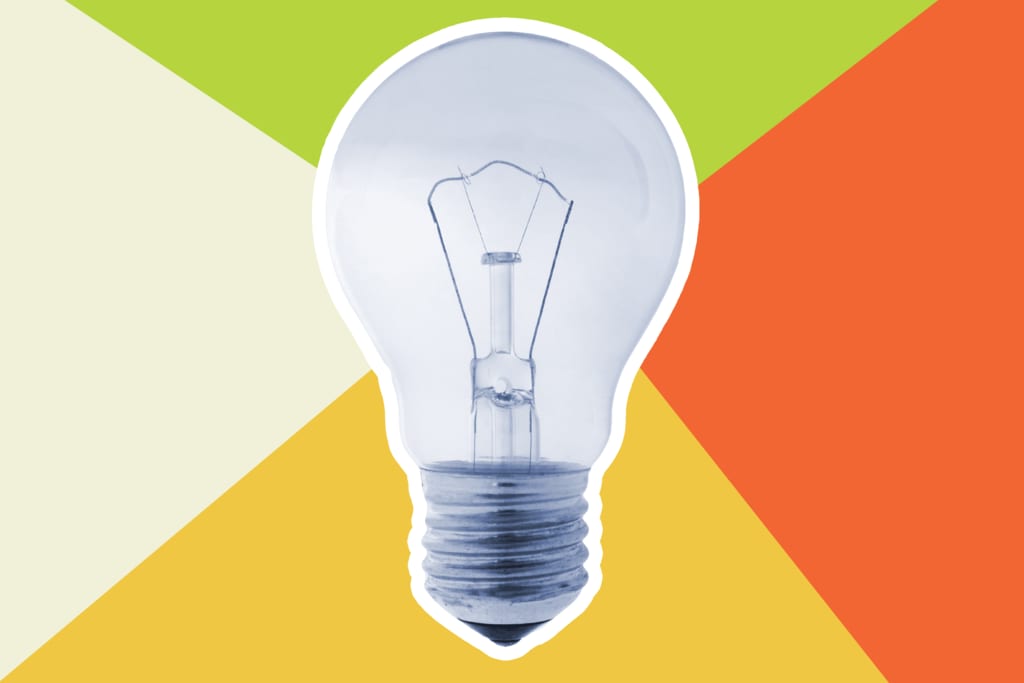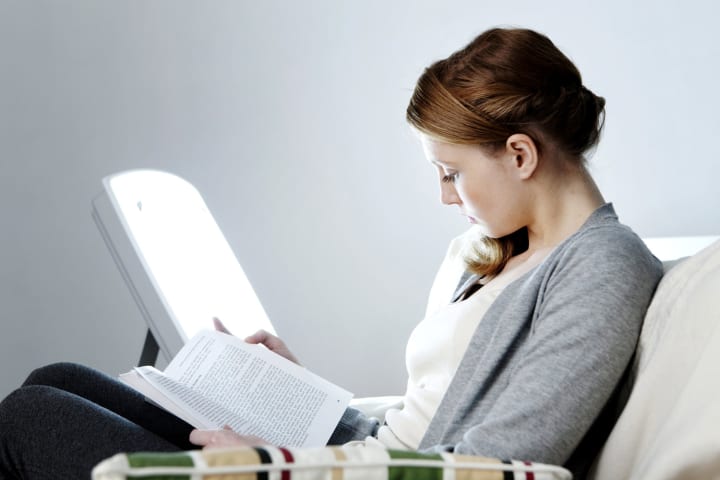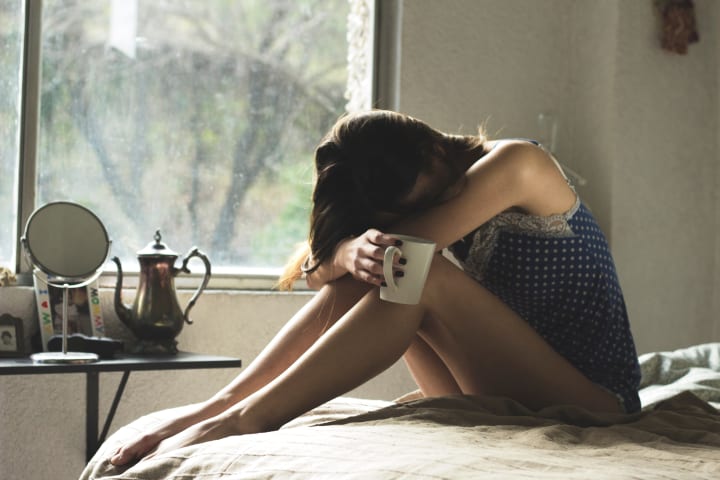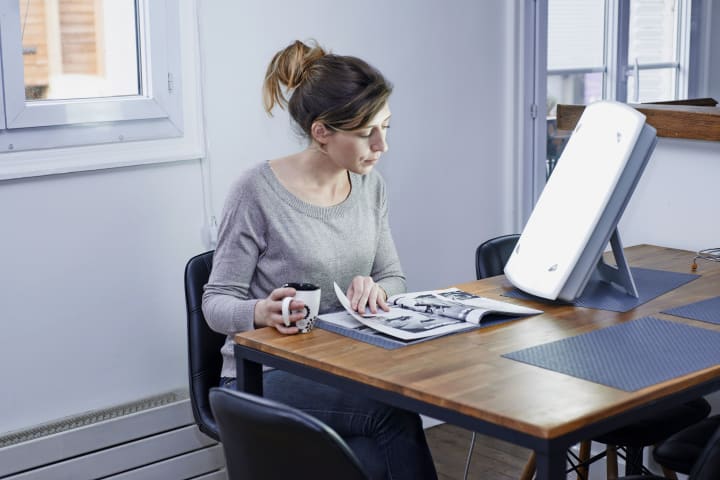Does Light Therapy Work for Depression and Anxiety?
Can chasing the blues away be as simple as turning on a lamp? Studies about light therapy suggest so.

It's just like clockwork. Every November, as the day grows shorter, my moods grow fouler. When March rolls by, my mood brightens. For the longest time, I thought that I was going crazy.
After years of wondering what was going on, I found out I had Seasonal Affective Disorder, or SAD for short. The reason why I was so grumpy has more to do with a lack of light than it did with the bitingly cold air. The most common SAD treatments are light therapy and vitamin D intake.
Having seen the difference a little light can make, I started to wonder if using lights could potentially allay other mental illnesses like depression and anxiety. Here's what science had to say about it, and why investing in specialty therapy lights might pay off.
Wait, what's light therapy, anyway?

There are many different therapies that exist out there, each of which has a unique method to help people who are suffering from a mental or physical illness. Therapy is used to both alleviate the symptoms, as well as treat mental illness.
Medication-based therapy uses psychotropic medicines like Xanax or Seroquel to help people who have depression or anxiety. Talk therapy is what most people think of when they consider mental illness treatments, however, it's not useful if you have a chemical imbalance in your mind.
People who want to avoid side effects from medications will often try other ways therapy can help you. Light exposure therapy is an alternative therapy that uses light rays as a way to help even hormones out in order to promote a better state of wellness.
The science behind light therapy is fairly solid.
As I've mentioned in the introduction, scientists have definitely ascertained that light (and a lack thereof) can have a serious effect on people. This is particularly true among individuals who are at risk for major depressive disorder, anxiety, or bipolar disorder.
Seasonal Affective Disorder's primary treatment is adding a minimum of 15 to 30 minutes of sun exposure into your daily routine. Exposure to natural sunlight has also been linked to vitamin D production; which in turn, has been known to stabilize moods.
If you've ever gone out for a walk on a sunny day, only to feel more energized after, you're not alone. The research backing the use of light as an energy and mood booster is very extensive, and stretches back decades.
When it comes to depression and anxiety brought by sleepless nights, light therapy also remains a proven treatment.

Researchers have also noted that exposure to light during the day while limiting exposure during the night helps people get better quality sleep. This has been found to be due to the way our sleep hormones react to light. By regulating light, you can actually regulate your sleep cycles.
Considering how much better people feel after a good night's sleep, it's not surprising that adding a little light therapy can help people prevent their mental illnesses from getting out of control.
Certain light therapy lamps have also been linked to better skincare.
Science has also shown that different lightwaves can have different effects on the body and mind. Red light, for example, has been linked to better skin rejuvenation, collagen creation, and scar tissue healing.
Many upscale skincare venues are now investing in specialized light exposure treatments for this very reason.That being said, red light doesn't do much for a person's mood. It's white light that you want to get.
Just going out in sunlight alone isn't enough to get the kind of perks you need in order to allay mental illness. To do this, you will need a specialized light that blocks out UV radiation, but still releases a bright white light.
Most therapists who use lights in treating anxiety, depression, or SAD suggest grabbing a therapy light that has 10,000 lux. This is around 20 times your typical indoor light's brightness.
The only time that you should consider using a light box that doesn't block out UV rays is when you have a vitamin D deficiency. Your body needs UV rays to create its own vitamin D.
If you aren't sure whether you need vitamin D, get a filtered light like the one above. Too much UV radiation without a deficiency in this vitamin will cause you skin damage.
Believe it or not, using lights to lift your mood and curb depression isn't that hard. Before you begin, position the light at 10 o' clock or 2 o' clock and keep the light around two feet away from your face. This angle helps you maximize the benefits of your light time.
You might also want to grab a magazine or an iPad to surf the net while you wait for your therapy session to happen. Then, just turn on the light and sit there for 15 to 30 minutes. That's all you have to do!
Once you start your light therapy session, consistency is key.
You might be wondering why you can't just go to a doctor's office and sit at their machine for a while. The truth is that you can, but it'd be very pricey and time-consuming to do so.
To get the full benefits of light therapy, you need to do it every day. Most experts would suggest doing it during the fall and winter seasons, since these are the months when most people don't get the light they need to stay emotionally healthy.
Light exposure therapy will affect everyone a little bit differently.
No body is the same, and every person's needs will be slightly different from one another's. Though this form of therapy can work wonders on people who have Seasonal Affective Disorder, sleep disturbances, or vitamin deficiencies, it's not for everyone.
One of the most important things you need to consider before starting therapy of this kind is whether or not you're photosensitive. People who have light sensitivity or are taking medications may react poorly to light, and should not try to use lights to make their moods better.
That being said, most people will feel a bit sunnier within two weeks of use.

Like with so many other things in life, consistency is key when it comes to light therapy. It needs to be done every day for at least two weeks (preferably a month) in order to see results.
If you regularly use your light box, then the effects you're going to see will mirror the way you feel in the summer, when there is plenty of natural sunlight in your life. After two weeks of daily use, you'll start to notice your mood pick up. After all, we can't always rely on niche meme therapy to keep our spirits high.
About the Creator
Rowan Marley
Rowan Marley is a 20-year-old sports enthusiast who hails from Brooklyn. When he's not hitting up a local Zumba class, he's drinking organic smoothies. That's just how he rolls.






Comments
There are no comments for this story
Be the first to respond and start the conversation.